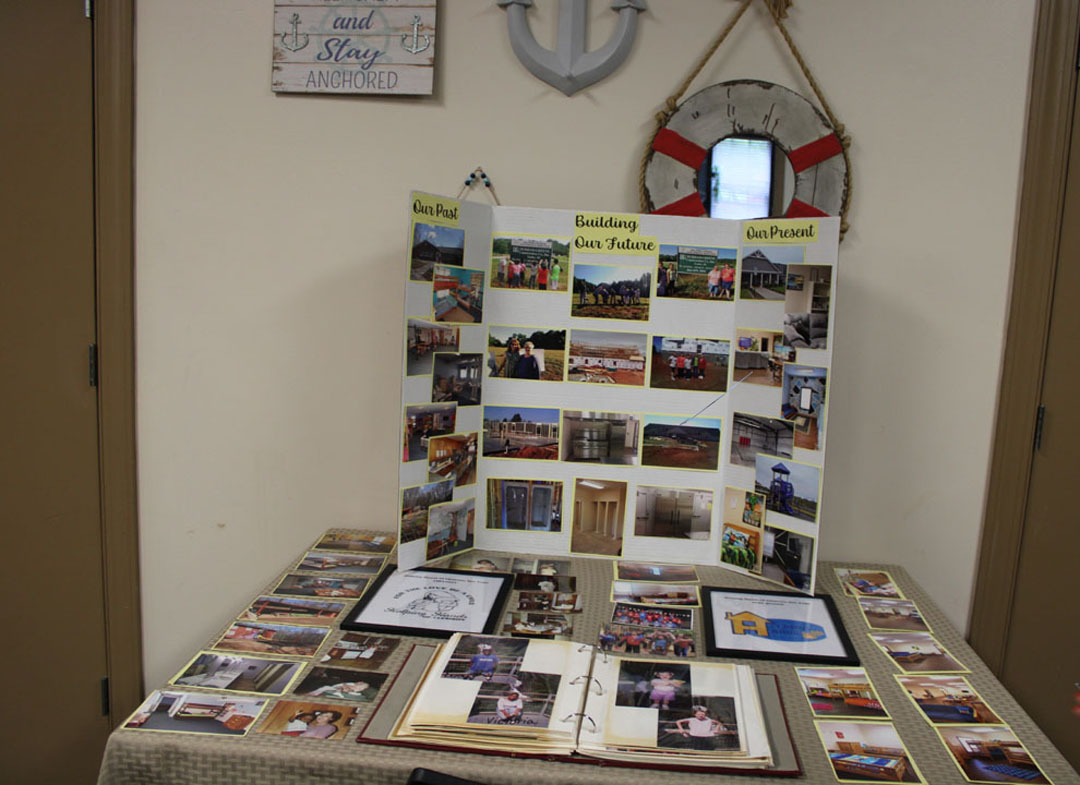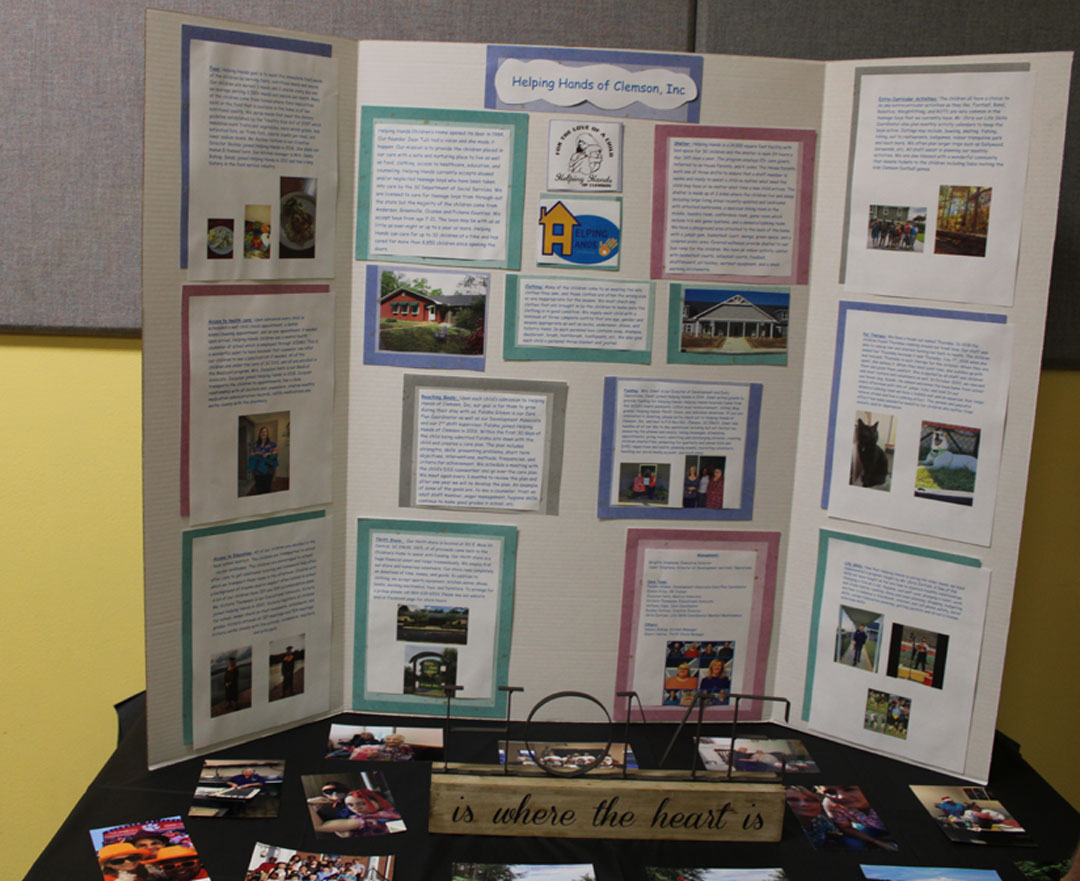Helping Hands of Clemson marks 40 years of caring for children and teens
By Karen Brewer, Publisher & Editor






Helping Hands of Clemson, founded as an emergency shelter and home for abused and neglected children and now a home for abused or neglected teenage boys in the custody of the Department of Social Services (DSS), is celebrating its 40th anniversary — 40 years of caring for more than 8,800 children and teenagers since opening its doors in 1984. In addition to the necessities of safety, housing, food, clothing, medical and dental care, and counseling, Helping Hands also provides them with much needed love.
The first home for Helping Hands was located in Six Mile. The current home was built in 2016 and was dedicated to Helping Hands’ founder, Jean Tulli, who had retired as Executive Director in 2011 but still served as a member of the Board of Directors and volunteered with the Helping Hands Thrift Shop in Central. (Tulli’s daughter, Jennifer Barbour, served as Executive Director until her passing on December 12, 2020. Tulli passed away on March 21, 2024.) In 2016, Tulli and Barbour led this writer on a tour of the new home as they celebrated that important milestone.
The current Executive Director of Helping Hands, Brigitte Stephens, and staff members welcomed several employees of DSS and led a tour of the home on Friday, August 16, 2024, the day of the 40th anniversary celebration — another important milestone — for the DSS employees and others from the community who had come to help mark this special occasion.
“We could not survive without community partners,” Stephens, who has been involved with Helping Hands for more than 20 years, including volunteering, told The Chronicle. In addition to donations, members of the community will bring by items they have bought while at a store. “We’re so appreciative,” Stephens said, “because you don’t realize how many items we go through a day, with that many boys.”
Members of the community also donate items to the Helping Hands Thrift Store, located at 311 East Main Street in Central. “It’s very successful,” Stephens said of the thrift store. “All of that money made pays every utility bill, there and here. We work hard at that thrift store.”
At the present, 16 boys live at Helping Hands. “But, sometimes, it’s 20,” said Stephens. “It fluctuates.” Helping Hands is now licensed for ages seven to 21 (in case siblings of different ages are needed to stay together at the home), but, at the present, Stephens said, one of the teens staying at Helping Hands is age 19, three are age 18, and the others range in age from 13 to 16.
In the laundry room, she said, “Imagine the laundry detergent we go through. And we have to teach independent living skills for the boys that are older, so they can survive out on their own, and so we teach them how to wash clothes.”
There are two sides, with bedrooms, in the home. Formerly, one side was for girls, and the other side was for boys. Now, one side is for the older teen boys, and the other side is for the younger ones. One side is decorated with an ocean theme, and the other side is decorated with a river theme. The younger boys have a game room, while the older boys have games in their room.
While they may sometimes go on outings and go out to eat, kitchen staff members at Helping Hands provide nutritious meals, in the dining room, for the growing teens each day. “These boys have an appetite,” said Stephens.
The playground was built when the home was new in 2016, when they still cared for young children, but they have since built a new gymnasium, for the older boys. “Our playground was intended for smaller kids when we moved here,” Stephens told DSS Director Michael Leach. “So, we’ve had to add on, but you would be surprised. We tried to get rid of that several times, and the boys said no.”
“My 13 year old would jump on that in a heartbeat,” said Leach.
“They still swing,” said Stephens. “And, when they get mad, they like to come out here and swing.” Another area outside, she said, “is for when they want to sit and talk with each other and work out their problems.”
The gymnasium was dedicated as the J.W. Barbour Activity Center in memory of past Director Jennifer Barbour, who had started it but passed away before its completion. While giving a tour of the gymnasium, Stephens spoke of how much the teens love to play basketball. “Our gym has half a court, so we’ll have tournaments, and we’ll do staff versus the kids. They get a kick out of that. One day, we had a volleyball tournament. And all of these kids are bigger than all of us women that work here. And I said, ‘We’ll have the staff versus the kids.’ And we won, actually. I couldn’t believe it.”
Outside is a soccer field and also an area for camping. “This year, the boys wanted to go camping,” recalled Stephens. “So, we thought we’d start here. They had a bonfire at night. They went out and got wood. They camped out. We told ghost stories.” But, then, they wanted to return to their own rooms inside, when it came time for sleeping. “They said, ‘I’m not sleeping out here,’” said Stephens.
During the tour inside, Stephens introduced one of the teenagers who played his electric guitar for the group. “We want the other kids to find out what they want,” said Stephens. “We have the ones that like football. Some don’t like sports, and they stay for clubs after school. We encourage them to do that.” Staff members provide transportation to football practice or wherever the teens need to go. “We want them to feel like they’re at home, and they can do what other kids do,” said Stephens. “They just want to be normal. That’s what they say.”
Stephens spoke of one teen who had been a weekend placement the week before. “When he came, I knew he was just a weekend placement, and he was leaving on Monday. I thought, how in the world are we going to be able to handle him? Because, before I left, I had to calm him down. He said, ‘I hate DSS. I’ve been lied to. I’m not going to another group home. I hate it.’ I said, ‘Will you please give us a chance?’ I said, ‘I see where you’re coming from. I get that.’ He wants to go to a foster home. And I said, ‘But will you just give us a chance?’ Saturday, he’s calling me, begging to stay here. When they came to pick him up, he didn’t want to leave, and it broke my heart. I’m feeling what he’s wanting. He said, ‘I want a foster home, but, if I can’t get a foster home, I want to stay here.’ And I said, ‘I’m so sorry. They’ve already found a placement for you.’ I couldn’t keep him, and that just ‘killed’ me. He was begging me.”
Stephens recalled the time three sisters were at Helping Hands (during the time they still took in girls). The sisters all returned later, to visit the staff. “They came back to visit, and they told us that they would have never got to do this or that, and they learned so much here. So, they were glad for the experience, even though they were away from their Mom. But, now, they’re back with their Mom, and I think they kind of teach her some things that they learned here.”
She recalled another youth, who had stayed for years, and also returned to visit Helping Hands. “He was one that I worried about, when he aged out. I knew he would go back home. We tried and tried to encourage him to go to school, stay here, and stay in DSS custody, but he just wouldn’t have it, and he went back home. Well, I think it was last year he came back with his mama, and with his wife, and he had bought his first house. I really worried about him. I thought, ‘he’s not going to make it.’ I was very surprised. I was pleased. And that’s why we’re here.”
Another former foster youth who lived at Helping Hands now has a full-time job at Michelin and returns to Helping Hands and helps with the current youth there. “He works so hard with these boys,” said Stephens. “It’s awesome that they can do that. We’re happy. We’re pleased.”
Others who come to help with the teens include Clemson University football and soccer players.
Stephens said that their goal is, several years after the youth leave Helping Hands, when they are adults, and they’re telling their story, they will be able to say, “I was in foster care. I was at Helping Hands, and it wasn’t all that bad. I enjoyed it.”
“Thanks for all y’all have done,” Leach told Stephens.
Leach, who has served as state Director of DSS since 2019, told The Chronicle that he had not yet visited Helping Hands and wanted to come to the open house. “I like to get out to where our children are placed,” he said. “This is great. They’ve taken young males and are helping teach life skills. You can tell they really care and are passionate about our young people. They’re making a difference. This place feels warm, a home.”
He noted the continued need for care for children in the foster care system. “There’s always a need,” he said. “There’s continued need for foster homes. It’s interesting to hear the history of having infants and toddlers. For the most part in South Carolina, young kids are in foster home settings, but our teens, sometimes, need different options. Some are going to do well in foster homes. Some are going to do well in this type of setting. I’m glad I got to come up here. It’s always good to see where are young people are.”
For more information about Helping Hands, please visit their website by clicking here.

















An area set aside to honor the memory of Jean Tulli, founder and first Executive Director of Helping Hands of Clemson (Photos by Karen Brewer, The Pickens County Chronicle)



An area set aside to honor the memory of Jennifer Barbour, Helping Hands' second Executive Director and a daughter of founder Jean Tulli (Photos by Karen Brewer, The Pickens County Chronicle)


Areas set aside for memories through the years (Photos by Karen Brewer, The Pickens County Chronicle)










